
REST API Made Simple
Understanding the Basics Through a Pizza Order Analogy
Let's break down the concept of a REST API by using a familiar scenario: ordering a pizza.
1. The Customer (You):
- You, as the customer, decide you want to order a pizza.
2. The Waiter (API):
- The waiter serves as the intermediary between you and the kitchen.
- You tell the waiter what kind of pizza you want. This is similar to how you make a request to an API.
3. The Kitchen (Server):
- The waiter takes your order and relays it to the kitchen. In this analogy, the kitchen represents the server.
- The kitchen then prepares your pizza based on the order details provided by the waiter. This step mirrors how the server processes the API request.
4. The Waiter Delivers Your Pizza (JSON Response):
- Once the pizza is ready, the waiter brings it back to you. This delivery is akin to the API sending back a response, often in JSON format, which is easy for your application to understand and use.
Real-World Example: Using a Weather App
Now, let's consider how this works in a practical scenario, like checking the weather on your favorite weather app.
1. Opening the Weather App (Client):
- You start by opening the weather app on your device. The app acts as the client in this interaction.
2. Searching for Weather Information:
- You enter the name of your city to check its weather. This action sends an HTTP request from your app to the server via the API, similar to asking, "What's the weather like in my city?"
3. Receiving the Weather Data:
- The server processes your request and sends back the weather information, usually formatted as JSON. Your app then parses this data and displays it in a readable format for you, showing details like temperature, humidity, and forecast.
Is Every API a REST API?
Not all APIs qualify as REST APIs. For an API to be considered a REST API, it must adhere to certain principles and constraints:
1. Client-Server Architecture:
- There must be a clear separation between the client and the server. This separation allows each part to evolve independently, enhancing flexibility and scalability.
2. Statelessness:
- Each request from the client to the server must contain all the necessary information to understand and process the request. The server does not store any state between requests. This ensures that each interaction is isolated and independent.
3. Cacheable Responses:
- Responses from the server must be explicitly defined as cacheable or non-cacheable. This helps in optimizing network usage by allowing clients to reuse responses when appropriate, thus improving performance and efficiency.
4. Uniform Interface:
- The method of communication between the client and server must be standardized. This typically involves using standard HTTP methods (GET, POST, PUT, DELETE) and consistent URL structures.
5. Layered System:
- The API architecture should be designed in a layered manner, with each layer having a specific function. This layered approach enhances security and scalability, as each layer can be managed and updated independently.
Summary:
In simple terms, a REST API facilitates seamless communication between different parts of a system, much like a waiter efficiently manages the interaction between you and the kitchen to get your pizza. By adhering to the principles of REST, these APIs ensure reliable, efficient, and scalable interactions in various applications, from ordering pizza to checking the weather.
Like, Share and Subscribe #DevTools99 for more useful videos, tools info and #tutorials . Thank you!
